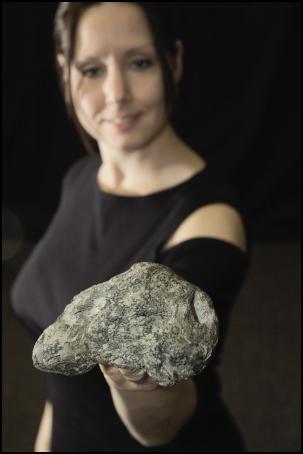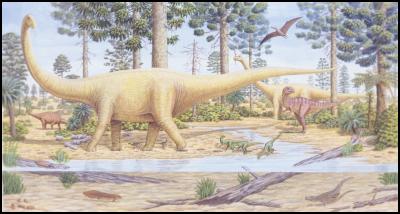Bone Find Shows Largest Dinosaur Lived In NZ
25 JUNE 2008
Bone Find Shows Largest Dinosaur Lived In NZ

A fossil hunter has discovered that one of the largest known dinosaurs, a titanosaurid, roamed New Zealand about 80 million years ago.
A vertebra bone discovered in a stream bed in Hawke’s Bay has been identified as coming from the giant plant-eating sauropod group known as the Titanosauroidea. This is the first evidence that titanosaurids once lived in New Zealand.
The bone was found by Dr Joan Wiffen west of Mohaka in northern Hawke’s Bay. It is not known if the fossil is from a juvenile or an adult.
Titanosaurids were widespread globally and lived during the Cretaceous period, between 83 and 65 million years ago. They had small heads, a long neck and tail, and a large body. They were up to 45 metres in length and weighed up to 50 tonnes.
Dr Wiffen, of Havelock North, found the bone during a routine fossil-hunting trip in a tributary of the Te Hoe River.
She said fossil-hunters like to explore streams after heavy rain as water could expose previously hidden fossil-bearing boulders.
“I saw a partly exposed concretion (sedimentary rock) about the size of a rugby ball in the stream bank. I dug it out and asked a colleague to break it open with a hammer.
“I immediately saw a bone structure inside that looked different from the bone of a marine reptile.
“To be honest it’s a fairly non-descript and incomplete bone. It is heavily eroded and that’s because it must have been transported in a riverbed for some time before it was buried. ”
Storms would have carried the bone down stream to what would have been a coastal lagoon or estuary 80 million years ago.
At home in her garage, Dr Wiffen painstakingly removed surplus rock and sediment with acetic acid and abrasion tools similar to those used by a dentist.
She took the bone to Dr Ralph Molnar, a recognised dinosaur expert, at the Queensland Museum in Australia.
“Straight away he became quite interested and he thought it might be a tail bone from a titanosaurid.”

Click for big version
Dr Molnar had the bone
examined by other vertebrate paleontologists who confirmed
his initial views.
Dr Wiffen and her team have now discovered fossil bones and bone fragments from six dinosaur species that lived in New Zealand. Three were meat eaters and three were herbivores. They have also discovered fossils of marine reptiles, notably mosasaurs and plesiosaurs, and the flying reptile – the pterosaur.
All of Dr Wiffen’s important fossil finds are held at the National Paleontology Collection at GNS Science in Lower Hutt. Dr Wiffen is in her 80s and has been a fossil collector for nearly 40 years.
GNS Science paleontologist Hamish Campbell said the find was particularly significant because it added to the knowledge of ancient New Zealand.
“It shows that New Zealand had the full range of dinosaurs. The titanosaurid would have lived several million years after Zealandia (the New Zealand continent) split away from Gondwanaland,” Dr Campbell said.
At this time, New Zealand was covered in lush rainforest and was a much larger land area than today – almost half the size of Australia. Dinosaurs became extinct 65 million years ago when a meteorite slammed into the Earth.
ENDS
Note: Although discovered in 1999, this
fossil find has only recently been published in a science
journal. The protocol in science is to publicise work only
when it has been peer reviewed and published in a science
journal.


 Fix & Fogg: NASA Hand-picks Kiwi Nut Butter Brand To Travel To Space In NZ First
Fix & Fogg: NASA Hand-picks Kiwi Nut Butter Brand To Travel To Space In NZ First Citizens of the Sea: Sailors To Revolutionise Our Understanding Of Pacific Biodiversity
Citizens of the Sea: Sailors To Revolutionise Our Understanding Of Pacific Biodiversity Netsafe: Making A Splash With Online Safety: Netsafe Launches New Flagship Programme For Kids
Netsafe: Making A Splash With Online Safety: Netsafe Launches New Flagship Programme For Kids NZGBC: Flood Resilience PhD Student Widi Auliagisni Named Future Thinker Of The Year 2024
NZGBC: Flood Resilience PhD Student Widi Auliagisni Named Future Thinker Of The Year 2024 Business Canterbury: European Free Trade Agreement A Game-changer For Canterbury
Business Canterbury: European Free Trade Agreement A Game-changer For Canterbury Business Canterbury: Urges Council To Cut Costs, Not Ambition For City
Business Canterbury: Urges Council To Cut Costs, Not Ambition For City



